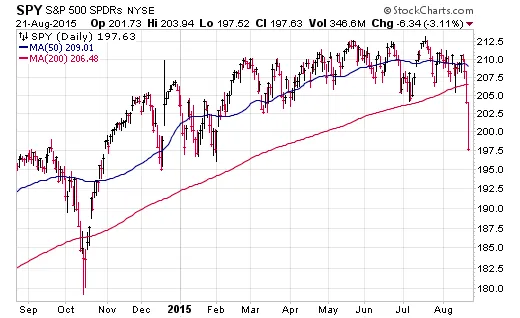By now you have likely realized something is up in the stock market. If you are like me, you have probably consumed a tremendous amount of reading material this weekend that has framed and/or extrapolated this recent pull back in a number of different scenarios. The end result is that stocks took a hard dive in a very short period of time and now everyone is scrambling to forecast the future or come up with a game plan in the midst of the chaos.
One of my favorite metaphors for the stock market is that it “takes the stairs (or escalator) on the way up and the elevator on the way down”. The elevator analogy most aptly describes this current drop. It has been vicious on the downside, and no matter how well prepared you are for it, there is now a sense of foreboding about what the future holds.
Let’s look at a sample of the major world markets through Friday’s close. @MichaelBatnick posted this chart showing some of the drawdowns from 52-week highs. The 7.51% drop in the S&P 500 Index translates into a total return of -4.27% year-to-date. Certainly not the optimistic spot I thought we would be in at this point in the year, but not a catastrophe either.
Percent from 52-week high (closing basis). pic.twitter.com/Ps8Dp6fg6y
— Irrelevant Investor (@michaelbatnick) August 23, 2015
For a more balanced perspective, the iShares Growth Allocation ETF (AOR) is down -2.08% this year. This index represents a 60/40 mix of stocks and bonds that is more in line with a typical investor portfolio.
Now, there are a million technical indicators that you can point to as evidence that the market “has to” or “should” bounce from here. Conversely, the bears are enthusiastic that the fundamental backdrop of equity valuations are now being re-priced closer to historical norms and are salivating to press their short bets.
Keep in mind that the market doesn’t have to do anything. It can stay oversold for far longer than you thought possible or it could reverse to new highs for seemingly no reason at all.
I have no idea what the next move will be, but at this stage I am more inclined to take advantage of the sell off than hoard more guns, canned goods, and gold. If you are worried about what the remainder of 2015 may bring, take a step back and evaluate your positions from an objective standpoint.
These three concepts may help you along the way.
- Avoid becoming overly pessimistic or reading too far into things. It’s easy to feed into the hype and extrapolate that the next two weeks may bring about the same ferocious selling that we have experienced over the last two weeks. I’m not trying to make light of the situation, but sell offs of 5-10% occur in every type of market with astonishing regularity. So far this is a very orderly and typical event. If you find yourself leaning too hard on the risk side of the ledger, look for opportunistic exit points (such as a short-term rally) to reduce exposure or transition to lower volatility positions.
- Watch out for the “I told you so” crowd. Anyone that is overly excited about this sell off likely has an ulterior motive, were lucky to sell near the highs, or have been wrong for quite some time. Taking victory laps as the market tanks doesn’t help anyone’s confidence or emotional capital. Rather, it’s important to focus on your investment process to ensure you have an appropriate asset allocation to meet your goals and risk tolerance. Make sure you identify the difference between a short-term trader that moves to cash quickly and a more strategic investment process that focuses on longer time frames or trends.
- Have a clear game plan for multiple scenarios. We could be at the brink of the next bear market or simply hitting a short-term speed bump. From a technical perspective, the SPDR S&P 500 ETF (SPY) has come right down to its January lows, which is a likely area of support. Nevertheless, a break below those levels could draw in more sellers looking to avoid the next significant drop to the October 2014 lows. Remember that if you do end up reducing your equity exposure, that swift rallies may lead to performance chasing on the way back up. It’s important to weigh the benefits and risks of changes to your asset allocation in the context of your investment plan rather than short-term emotional pressures.

The Bottom Line
Keeping a level headed approach to the market will allow you to make changes in the face of adversity with far greater success than a fear-driven impulse. There have been several opportunities this year to take advantage of new trends or step up your risk management plan as needed. The key is to stay as objective as possible when making changes to ensure they align with your long-term goals.
Looking for new ETF ideas? Check out our library of free special reports on growth and income investing.